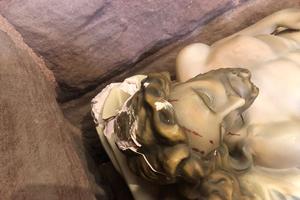Grandmother and Her Grandchildren Work to Restore Fargo Cathedral Statue Destroyed by Vandal
Marilyn Loegering’s artistic talents have been put to work for years at the Cathedral of St. Mary in Fargo, North Dakota, keeping the statues and artwork in the sanctuary looking their best. So when Loegering was asked by church staff to try to restore the ‘Christ in Death’ statue, she knew it was the perfect opportunity to bring in some help — her grandchildren, a niece, and a friend.

Editor’s Note: New Earth magazine is published by the Diocese of Fargo, North Dakota. This story was reprinted with permission via CNA.
Marilyn Loegering is no stranger to difficult projects. Her artistic talents have been put to work for years at the Cathedral of St. Mary in Fargo, North Dakota, keeping the statues and artwork in the sanctuary looking their best. But even she was shocked at what she saw in late January.
“I’ve repaired many of the statues at the cathedral, including the entire Nativity set,” Loegering said. “I do it for the church, not for a living. The first time I saw the damage I thought, ‘My gosh, do I have a big project this time.’”
That project was restoring the badly damaged Christ in Death statue that has been a fixture in the cathedral for nearly three decades. Brittany Marie Reynolds, 35, is accused of entering the cathedral on Jan. 23 and pulling the statue from its display, sending it crashing to the floor below. She was arrested by Fargo police shortly afterward and has been charged with criminal mischief.
“I felt sadness,” Loegering said. “Why would this ever happen? It was pretty much slammed to the floor so corners were damaged, the head was destroyed, the foot was destroyed, along with the canvas.”
The good news is the statue was made of plaster, which is easier to work with than porcelain. And when Loegering was asked once again by church staff to try to restore it, she knew it was the perfect opportunity to bring in some help — her grandchildren, a niece, and a friend. Soon, grandchildren Maria Loh; Hanna, David, Grace and Emily Loegering; niece Jamie Keller; and family friend Isaac Olson were recruited to do the job.
“Getting to work with Grandma was very special,” Loh said. “I’ve worked with her on a few painting projects here and there, and she’s taught me so much of what I know about art. I would not even know how to hold a paintbrush without her. Using the skills working with her that she taught me is really in a way like giving back.”
While Loegering restored the foot of the statue, the others set to the task of repairing the rest. Loegering said each brought a unique set of skills to the project. For example, Hanna and David Loegering are very good at airbrushing, and Loh knew through her chalk drawings how to mix different colors. There were exchanges of ideas, critiques of each other’s work, and skills learned from one another. In a sense, the project was a spiritual Lenten journey for the young artists.
“Just before Ash Wednesday the statue was destroyed, so it kind of goes along with our liturgical cycle,” Hanna Loegering said. “We’re supposed to die to ourselves and learn and grow spiritually, and being able to repair the statue before Holy Thursday so it could be back at the church for Good Friday was really great.”
“Getting to work on the statue, especially the dead body of Christ, was really a special experience,” Loh said. “It was almost a reflection of getting to minister to the body of Christ. Even though it was just with a paintbrush, it really brought insight into what it might have been like for the women who were mourning for him, especially Veronica, who wiped the face of Jesus. We were literally wiping the face of Christ to get the dust off, so it brought this whole new meaning to being able to be that close to Christ.”
For Marilyn Loegering, the tragedy was an unexpected blessing — a chance for the next generation to carry on after she’s gone.
“This project was perfect for training someone else to learn and to pass down the knowledge, because it’s time someone else learns to do this,” she said. “I’ve never experienced greater joy than to have worked with my grandchildren as they did the Lord’s work. I think the statue looks better than ever!”


















